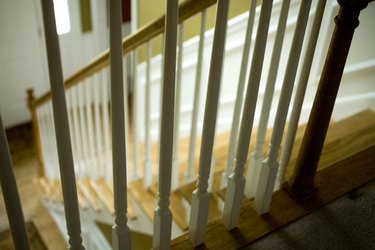
Merriam-Webster defines a stringer as "a long horizontal timber to connect uprights in a frame or to support a floor." This is precisely the role that stringers play in the construction of a staircase. Stringers are the support on which the steps of your staircase rest. They give the staircase shape and allow it to extend a walkable surface from the floor below to the landing above.
Function
Video of the Day
The stringer serves several functions in the staircase structure. The stringer bridges the gap between two floors. It also joins the gap between the floor or rim joists of the upper level with the floor surface of the lower level. Stair stringers also provide a strong foundation for each step in the staircase. The risers and treads of each step are directly attached to your staircase stringers. The stringers hold them in place and provide the support necessary to hold up anyone who might use the stairs. In addition, stair stringers are the template on which the size and shape of your staircase is cut. They determine the run and rise of your staircase, the depth of every step, the amount of area on every tread, and the overall width of your stairs. The stringer can also serve as the outside edge of your stairs, enclosing the structure within and creating a finished look.
Video of the Day
Types of Stringer
Stair stringers can be of the open or closed varieties. Closed stringers are set at the edges of the staircase and overlap the ends of each step. They provide support for the stairs and also lend a bit of cosmetic finish to the overall look of the staircase. Closed stringers may be notched or have small ledges at each step for extra support. Open stringers follow the cut of the stairs and do not overlap the edges. Stairs treads and risers are attached directly to the vertical and horizontal faces of open stringers. Open stringers are often used as a center support for all types of staircase.
Calculating a Stringer
To calculate the shape of your stringer you will have to determine several measurements. To find the rise and run of your stair stringer, the distance between your lower floor and your upper landing must be divided by the amount of steps your stringer will support. If your upper landing is 10 feet above your lower landing, and each step is 8 inches high, your stringer will have to support 15 steps, because 120 inches divided by 8 inches, equals 15.
Non-Staircase Stringers
The term "stringer" refers to any horizontal beam or structural element which joins two verticals. The lower horizontal structure of a bridge that spans the two piers is a stringer. So, too, are the planks of a bench that join the end supports. Stringers appear in man-made structures other than the staircase.